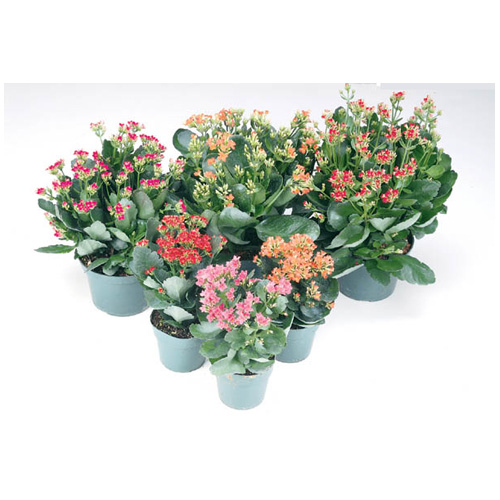Kalanchoe is a tropical plant that requires minimal maintenance and produces lovely long-lasting blossoms. This famous succulent comes in a rainbow of colors, including yellow, pink, magenta, orange, and red. Because the green leaves are lustrous and rather huge, they make a statement. Kalanchoe is easy to care for, but there are a few things to keep in mind.

Light Requirements
Kalanchoe thrives in strong, natural light, so keep it near a South-facing window in the winter and an East-facing window in the summer. As long as the plant doesn’t get too much direct sunlight and isn’t near any hot windows, a medium or high light environment is ideal.
Kalanchoe will thrive outside in the summer as long as it is sheltered from the intense afternoon heat. Kalanchoe gets leggy and thin if it does not receive enough light, and its blooms do not open.
Temperature Requirements
The temperature can reach up to 55 degrees Fahrenheit in Kalanchoe, but it never goes below that. Ideal temperatures lie between 60 and 85 degrees Fahrenheit.
In regular household settings, this plant thrives, although it must be kept away from drafts. Kalanchoe is sensitive to chilly temperatures, so keep it away from cool windowsills.
The sooner the blooms open up, like with any flowering plant, the warmer your environment is.
Don’t Overwater
Because kalanchoe is succulent, it should not be kept damp. Fill the drainage tray with water and water the plant thoroughly until the water flows out the bottom. Then, before watering again, let the soil surface dry off.
Your Kalanchoe will need to be watered more frequently depending on the temperature in your home, the amount of light available, and its size.
Be sure to check your mini plant’s soil surface often and to water it more often since micro plants need more regular watering than larger plants.
Keep in mind not to overwater Kalanchoe, and that letting it lie in moist soil might promote root rot. Kalanchoes don’t require any misting in winter homes because of the low humidity. You can minimize the frequency of your watering in the winter.
Select a Soil That Drains Well
Kalanchoes should be planted in soil that is well-drained and well-aerated, such as a mixture of 60% peat moss and 40% perlite. Because the roots can be fairly sensitive, use a clay container.
What About Fertilizer?
During the blooming time, feed Kalanchoe once a month with a balanced organic fertilizer.
Propagating Your Plant
Kalanchoe stem cuttings are the easiest approach to grow the plant. While the plant is blossoming, avoid propagating it. The best seasons are spring and summer.
Remove the leaves at the bottom of a 2- to 3-inch portion. Allow the cutting to dry out in a warm, dry area to produce a callus.
Then, up to the first leaf, place the cutting in damp soil. Use the pot to make a mini terrarium by wrapping it in plastic and placing it next to a window with indirect light. In 14 to 21 days, cuttings will root and be ready to transplant.
Blooming
Kalanchoe can spontaneously rebloom in the spring or late fall. You may push your plant to blossom again if it isn’t already. Kalanchoe responds to light and dark exposure in equal amounts. It requires 12-14 hours of continuous darkness for 6 to 8 weeks to blossom again.
For 12-14 hours, hide your plant in a closet or a dark area after bringing it out only in the morning. Reduce the amount of watering you do at this period. Temperatures of 40-45 °F (4-7 °C) at night and 60 °F (16 °C) during the day are ideal for reblooming. You can resume your regular care regimen after the buds develop.
Diseases
Aphids and mealybugs can attack Kalanchoe. Keep an eye on your plant and inspect it periodically, especially behind the leaves. Both dogs and cats are poisoned by KalanchoeKalanchoe is susceptible to powdery mildew, so don’t spritz or spray it.
Mini Kalanchoe Frequently Asked Questions
Is it necessary for kalanchoes to be exposed to direct sunlight?
Sunlight: Bright light with no direct sun. Direct sunlight can burn the tops of the leaves, but bright light will assist keep the blossom color. Well-drained soil is essential. Whether planted indoors or outdoors, they require little water.
Is it possible to cultivate kalanchoe in the shade?
Kalanchoe is a lovely plant with a wide range of blooming variants. If kept in full sun or a bright place with a few hours of direct sunshine, it will blossom profusely. Put it in a shaded spot, and its lush dark green leaves will keep you entertained.
Is kalanchoe considered succulent?
In flower shops and garden stores, you can typically find kalanchoe plants with thick leaves. Most end up as potted plants, however, they may be grown outdoors in locations that are similar to Madagascar’s natural country. The enormous bloom is kept aloft on stalks above the rest of the foliage by clusters of smaller blooms.